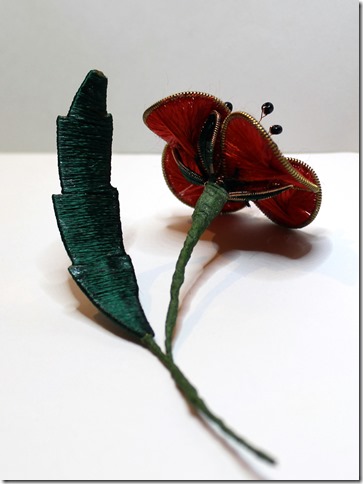Good afternoon. I have been learning the technique of Ganutell flower making. This year I made a donation to the Poppy Appeal but made my own Remembrance Poppy.
I adapted instructions from the Ganutell Country Flowers Handbook from Gina B Silkworks. I used red stranded Rayon Floss to wrap the petal wires and DMC Satin to wrap the Cartouchage (card wrapped) leaf. The centre was created with yellow stranded cotton and black seed beads.
I also used 0.25mm and 0.4mm copper wire, 1.9mm Perl wire (Vintage Brass) wires. The 1.9mm ready made Perl is a little more robust than hand wound (from 0.4mm wire) so I thought it more suitable for making into a brooch, helping to keep the shape of the large petals.
Florist tape (green) was used to wrap exposed stem wires. I added a pretty Posy Holder and Pin to make it into a brooch.
As a beginner I really struggled with using slinky Rayon Floss threads. The DMC Satin thread was a delight to use when compared to standard Rayon Floss – so if you are a beginner I would recommend this. I separated out the DMC Satin strands and used singly for the small Ganutell sepals (with fine Perl wire). I recombined several strands back together to cover the Cartouchage large leaf.
Shapes for the leaf and flower centre can be hand cut from the templates in the book or you can use ready cut card shapes from the Cartisane Flower Cards Kit).
I discovered a fantastic trick to help create a smooth Rayon Floss for the petals. I had initially just been separating the strands and spritzing with water to help smooth out the kinks and help the thread to lay flatter. This worked quite well but it still never looked totally smooth and neat. I applied my science brain to the problem and developed this trick to achieve super smooth thread. It may be that experienced embroiderer’s already know this technique but I haven’t seen it anywhere.
I found that if I separated the strands, each strand is composed to 2 ply. I then separated into a single ply. If this is gently stretched the thread ‘memory’ and kinks can be removed leaving a smooth singly ply thread which lays lovely and flat and behaves more like a filamentous silk. Now that I have found this trick I can see so many uses for this thread. I had long given up on it for embroidery of cross stitch etc. as it just would not lay flat and always looked messy in my stitch work.
In this close up you can see how smooth the thread lays after treatment.
Here is an example of petals made with Rayon Floss. The white petal was created by wrapping with a single floss strand. You can see that it looks ‘bouncy’ and does not lay flat, also the twist in the ply is obvious as the light catches the shiny strands. The yellow petal was created using 1 stretched ply each of yellow and white Rayon. The results are so much smoother and neater.
Many years ago I purchased a stash of Rayon Floss to use in embroidery, hoping to be able to use it as a more affordable alternative to silk for silk shading and for Cross Stitch etc. I was so disappointed when it just simply looked a mess. They were consequently stuffed into my stash and rarely used except for occasionally in braid making. I now view these threads with excitement again. I hope that this little trick will be useful to any of you that have been disappointed when using this type of thread.
The Poppy looks lovely displayed alongside one of the pretty butterflies. These were created from the Ganutell Butterflies Kit (Blues) – details blogged previously. The little vase in this picture was created using my own fabric plus the Vase Heritage Pincushion Kit – also from Gina B Silkworks. The kit contains precision cut cards and full instructions. I fussy cut my fabric to place the motifs around the vase.
Tools required:
Jewellery pliers or tweezers, wire cutters (scissors can be used instead but don’t use your best ones!), clear drying PVA glue and a ruler.
Optional extras:
These are not essential but really useful if you intend to make a few projects. A small piece of florist foam (for holding elements while glue dries), and the Petal and Leaf Jig (to help shape wires easily and consistently).
I am planning a large Ganutell floral display – so more Ganutell to share with you all soon xxx.








